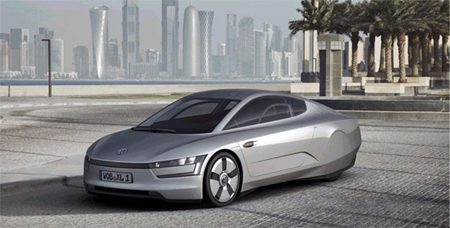VW has said it is building some production examples of the XL1 coupe seen at the motor show in Qatar last year as a concept. The reason this has generated such a buzz is because Volkswagen is quoting fuel consumption figures of 0.9 L/ 100 km (313 mpg for those working on the old standards). That makes it the most frugal car on the planet.
Weighing in at only 795 kg, VW has used pioneering construction techniques, an advanced plug-in hybrid drive train and innovative packaging all play a part in allowing the XL1 to return that 313 mpg on the combined cycle while emitting 24 g/km of CO2 to set a new benchmark for vehicle efficiency.
 VW XL1.
VW XL1.
Powering the XL1 is a compact 800 cc TDI two-cylinder common rail diesel engine developing 35 kW of power and 121 Nm of torque with an electric motor adding another 20 kW and 100 Nm – a modest output yet more than enough when the low kerb weight of the vehicle is taken into account.
The TDI engine is linked to the electric motor and a seven-speed DSG gearbox with an automatic clutch mounted between each unit. The electric motor can either work independently of the TDI engine or in tandem when accelerating. In pure electric mode the XL1 can travel up to 35 km before the diesel engine cuts in. Accelerating from rest to 100 km/h takes 11.9 seconds; and the electronically limited top speed is 160 km/h. Neither is a staggering performance figure, but the car is designed for city use, and those figures are more than adequate.
In both its styling and packaging the XL1 draws on lessons learned from the 1-Liter car (2002) and the L1 concept (2009). The XL1 has evolved to feature staggered seating with the driver and passenger placed next to each other in a body structure made from advanced new materials providing immense strength yet weighing just 230 kg.
To make such weight savings possible, and yet viable for series production, Volkswagen developed and patented a new system for the manufacture of the Carbon Fibre Reinforced Polymer (CFRP) parts on the car called the Resin Transfer Moulding (RTM) process. Further savings are made through the extensive use of lightweight materials including magnesium (wheels), ceramics (brake discs) and aluminium (dampers, steering system, brake calipers).
The styling of the XL1 is borne out of functional requirements – easy access to the interior is granted via a pair of scissor doors that hinge on the A-pillar while the profile of the car has been designed in the wind tunnel, the result being a remarkable coefficient of drag figure of 0.186. This makes it more aerodynamic than a Ferrari 458 Italia which has a co-efficient of drag of 0.32; (the lower the number the slipperier the car). The XL1’s overall length (3,970 mm) and width (1,682 mm) are similar to those of a Volkswagen Polo yet its height (1,184 mm) is more akin to that of a Lamborghini Gallardo Spyder.




